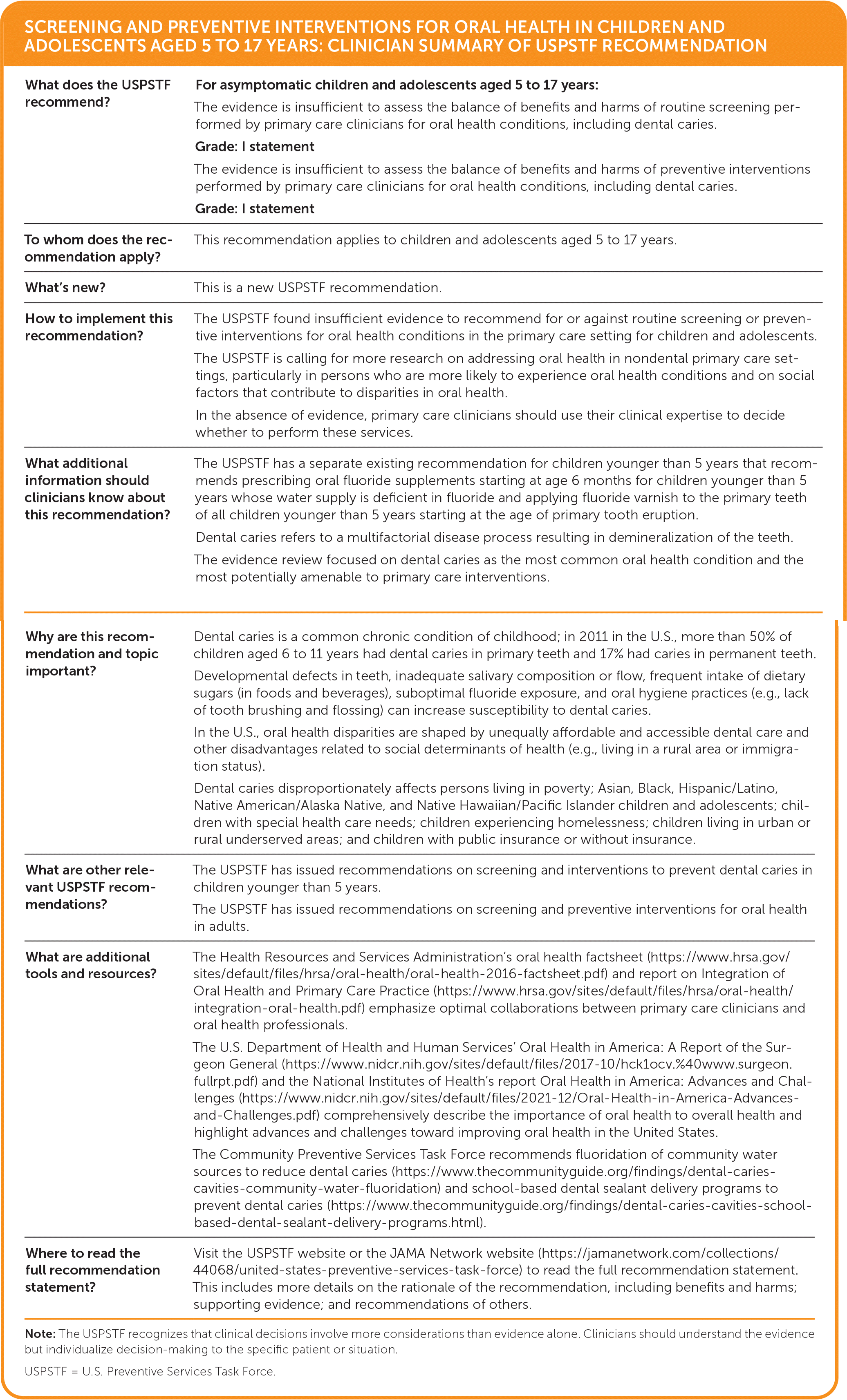
U.S. Preventive Services Task Force
Screening and Preventive Interventions for Oral Health in Children and Adolescents Aged 5 to 17 Years
Am Fam Physician. 2024;109(2):online
As published by the USPSTF.

| What does the USPSTF recommend? | For asymptomatic children and adolescents aged 5 to 17 years: The evidence is insufficient to assess the balance of benefits and harms of routine screening performed by primary care clinicians for oral health conditions, including dental caries. Grade: I statement The evidence is insufficient to assess the balance of benefits and harms of preventive interventions performed by primary care clinicians for oral health conditions, including dental caries. Grade: I statement |
| To whom does the recommendation apply? | This recommendation applies to children and adolescents aged 5 to 17 years. |
| What's new? | This is a new USPSTF recommendation. |
| How to implement this recommendation? | The USPSTF found insufficient evidence to recommend for or against routine screening or preventive interventions for oral health conditions in the primary care setting for children and adolescents. The USPSTF is calling for more research on addressing oral health in nondental primary care settings, particularly in persons who are more likely to experience oral health conditions and on social factors that contribute to disparities in oral health. In the absence of evidence, primary care clinicians should use their clinical expertise to decide whether to perform these services. |
| What additional information should clinicians know about this recommendation? | The USPSTF has a separate existing recommendation for children younger than 5 years that recommends prescribing oral fluoride supplements starting at age 6 months for children younger than 5 years whose water supply is deficient in fluoride and applying fluoride varnish to the primary teeth of all children younger than 5 years starting at the age of primary tooth eruption. Dental caries refers to a multifactorial disease process resulting in demineralization of the teeth. The evidence review focused on dental caries as the most common oral health condition and the most potentially amenable to primary care interventions. |
| Why are this recommendation and topic important? | Dental caries is a common chronic condition of childhood; in 2011 in the U.S., more than 50% of children aged 6 to 11 years had dental caries in primary teeth and 17% had caries in permanent teeth. Developmental defects in teeth, inadequate salivary composition or flow, frequent intake of dietary sugars (in foods and beverages), suboptimal fluoride exposure, and oral hygiene practices (e.g., lack of tooth brushing and flossing) can increase susceptibility to dental caries. In the U.S., oral health disparities are shaped by unequally affordable and accessible dental care and other disadvantages related to social determinants of health (e.g., living in a rural area or immigration status). Dental caries disproportionately affects persons living in poverty; Asian, Black, Hispanic/Latino, Native American/Alaska Native, and Native Hawaiian/Pacific Islander children and adolescents; children with special health care needs; children experiencing homelessness; children living in urban or rural underserved areas; and children with public insurance or without insurance. |
| What are other relevant USPSTF recommendations? | The USPSTF has issued recommendations on screening and interventions to prevent dental caries in children younger than 5 years. The USPSTF has issued recommendations on screening and preventive interventions for oral health in adults. |
| What are additional tools and resources? | The Health Resources and Services Administration's oral health factsheet (https://www.hrsa.gov/sites/default/files/hrsa/oral-health/oral-health-2016-factsheet.pdf) and report on Integration of Oral Health and Primary Care Practice (https://www.hrsa.gov/sites/default/files/hrsa/oral-health/integration-oral-health.pdf) emphasize optimal collaborations between primary care clinicians and oral health professionals. The U.S. Department of Health and Human Services' Oral Health in America: A Report of the Surgeon General (https://www.nidcr.nih.gov/sites/default/files/2017-10/hck1ocv.%40www.surgeon.fullrpt.pdf) and the National Institutes of Health's report Oral Health in America: Advances and Challenges (https://www.nidcr.nih.gov/sites/default/files/2021-12/Oral-Health-in-America-Advances-and-Challenges.pdf) comprehensively describe the importance of oral health to overall health and highlight advances and challenges toward improving oral health in the United States. The Community Preventive Services Task Force recommends fluoridation of community water sources to reduce dental caries (https://www.thecommunityguide.org/findings/dental-caries-cavities-community-water-fluoridation) and school-based dental sealant delivery programs to prevent dental caries (https://www.thecommunityguide.org/findings/dental-caries-cavities-school-based-dental-sealant-delivery-programs.html). |
| Where to read the full recommendation statement? | Visit the USPSTF website or the JAMA Network website (https://jamanetwork.com/collections/44068/united-states-preventive-services-task-force) to read the full recommendation statement. This includes more details on the rationale of the recommendation, including benefits and harms; supporting evidence; and recommendations of others. |
The full recommendation statement is available at https://www.uspreventiveservicestaskforce.org/uspstf/recommendation/oral-health-children-adolescents-screening-preventive-interventions.
The USPSTF recommendations are independent of the U.S. government. They do not represent the views of the Agency for Healthcare Research and Quality, the U.S. Department of Health and Human Services, or the U.S. Public Health Service.

